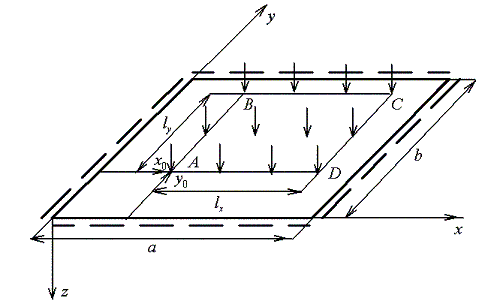User has to enter the moduli of elasticity Ex and Ey of the material in x-axis and y-axis directions, shear modulus Gxy , as well as Poisson’s ratio νyx. The second Poisson’s ratio is calculated using formula νxy=νyxEx / Ey. We also check the restriction νxyνyx < 1 for orthotropic material and 0≤ νxy ≤ 0.5 for isotropic material before the calculation. In the case of isotropic material the field for shear modulus can be left blank. Corresponding value will be calculated by formula Gxy=Ex /(1+ νyx)/2 .
While entering load characteristics, please use the coordinate system shown in figure. You have to enter the value of load q, lengths of rectangle loading area ABCD in both directions lx and ly , as well as coordinates of point A x0 and y0. The sides of rectangle ABCD are parallel to the sides of the plate. The case of concentrated load can be considered in this calculation by choosing relatively small area ABCD (for example putting lx=a/100 and ly=b/100.
Please use the same system of units throughout the calculation. For instance,
if you use force unit N and length unit m, the unit of load and modulus of elasticity
should be N/m2.
Obviously, the result of calculation will have the same unit system in this case:
deflection – m, stresses – N/m2.
The program calculates the characteristics of the loaded plate: maximum of deflections and maximum of main stresses in different directions, including principal, von Mises and shear stresses with indicating where these maximums occur.


